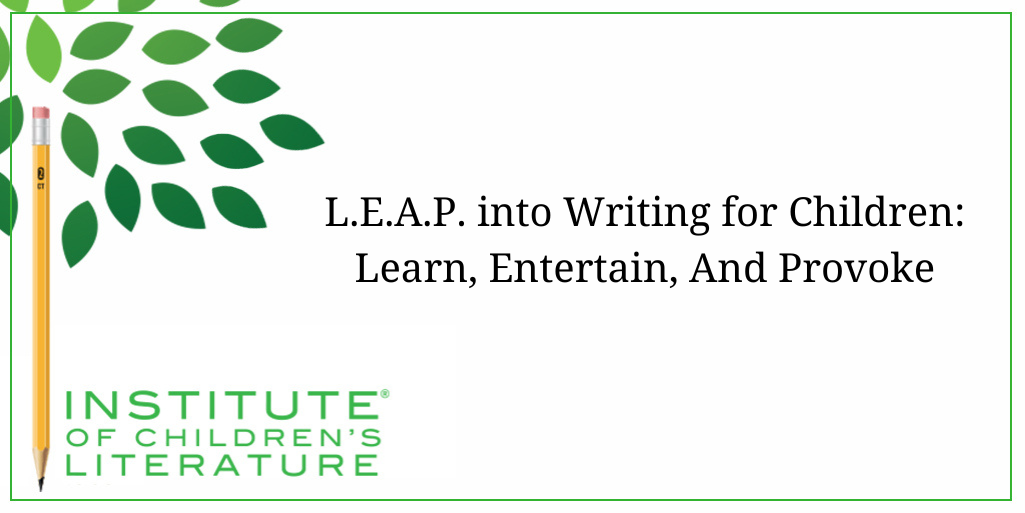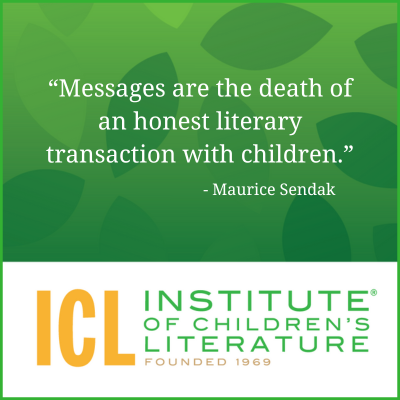
5 Ways Writers Can Prep for 2025 Goal Setting
Before we roll on to the new writing year, let’s harness our optimism for the blank slate before us and prepare for our 2025 Goal Setting just for writers.

When I was a kid, I loved to read. I would happily pass an entire day reading with nothing but bathroom breaks. When I was deep in a book, I’d even forget about being hungry.

None of these stories were meant to be lessons but I learned anyway. As I’ve thought about how I (a kid who loved reading) interacted with books, I’ve come to realize what I need to do to create books kids will love. I need to take a LEAP when writing for children. By that, I mean creating a story that teaches (LEARN), captivates (ENTERTAINS), AND gets the child to do something (PROVOKES).
Weary teachers might think getting kids to learn can be a chore, but the reality is that kids love to learn. Of course, they also like doing it on their terms, which I can relate to.
For instance, I once met an 8-year-old whose depth of knowledge about sharks was astonishing. He knew about what differentiated the different kinds of sharks. He could tell you about how they hunted and whether they hunted at all. He knew about how they sensed prey, how they behaved socially, and how they reproduced. Sharks weren’t even on his school curriculum. He learned about them because he found a book that captured his attention, and from there he tracked down shark information everywhere. His family even planned a vacation around going somewhere he could see sharks. For him, this learning was fully integrated into his life and it made him seek out more learning. This same kid acted as if doing a math worksheet was a new form of torture. So, he wasn’t an easy student, but he was an eager learner. They don’t always coincide.

For instance, if you were writing a story about a kid who falls from a boat and is rescued by a friendly shark, that’s not a great idea. There are no friendly sharks. There are indifferent sharks, curious sharks, hungry sharks, and sharks who just haven’t noticed you yet. But friendliness is not one of their motivations. If you’re going to have the child saved by a creature capable of altruistic behavior, you need something different from a shark.
In other words, you need to avoid introducing errors. Don’t introduce errors—not even in your fiction. Kids will learn from your writing whether you want them to or not, so be sure whatever you teach is valuable and accurate.
Learning in fiction is about discovery. Kids discover something in the story that they didn’t know before, and it becomes one of the things they now know. Discovery is the very best way to learn because it’s very personal learning. It isn’t something you do for someone else, it’s something you do for you. This is one reason why lecturing doesn’t work well as a learning tool in children’s fiction. When children work something out on their own or discover something in the story, they retain the learning better. Children are lectured about so many things that most have lecture-overload and will actively resist receiving force-fed learning.
This is also why many publishers ask for “positive role models” in their submitted stories. They prefer these positive role models over characters who do bad things and are taught a lesson in the text. If readers like a character, they’re more likely to side with the character against anyone conflicting with the character. That can make them side with the character doing bad things over the characters there to teach them a lesson. That doesn’t mean characters should never learn from their mistakes, but they should do it naturally through their own discovery and decision, not through outside correction “teaching” them a lesson.
The best learning happens when you provoke curiosity in the reader (what’s going to happen next?) and then pay it off with something new and unexpected. That’s the learning that lingers.
If you’re hoping to sell your writing, telling a good story is essential. It needs to feel important to the characters involved. The characters need to do things in the story based on how important you make it. And the behavior of the character needs to be important to the story ending. That doesn’t mean you can’t have a more “day in the life” story (especially for very young children) but it needs to be an extraordinary day in the life of discovery. The day must have unique and exciting things in it.

Can you have a traveling story like this that is exciting? Sure. You can make the kids travel to the grandparents’ house in an extraordinary or unexpected way. Maybe they take the trip on Amtrak. They’ve never done this. They go to the train station. They see surprising things there (maybe surprising people too). They deal with luggage. They get on the train. They meet people. They pass other trains and see them through the window. In other words, they have an adventure that not every kid has. This is different. And this is a day of discovery. At the end of the story, the reader knows what riding the train is like. So, not only are you writing for children a story that is interesting because it’s filled with things the reader didn’t know, but you also have a story that parents will like if they’re going to be taking the kid on the train. It’s a good “prep” story.
And if you want your train story to be especially great, give the child character something to succeed at. Something he can do that not everyone can. Maybe the parent traveling with the child drops something essential (ticket? car keys? a special thing they’re taking for the grandparents?) and it falls into a tight space. The adult can’t reach it, but the kid can because the kid is small. The kid fetches it and it’s available at the end when we need it because that child saved the day.
In a story like that, the reader would love the story for two reasons: the unique setting and things learned through it, and because of the main character’s importance to the story. Even a “day in the life” piece can add an element of plot to elevate it and make it even more appealing.
When writing for children, very story should leave the reader with something. It might be something to think about. In a story with sibling conflict, for instance, you might leave the reader thinking about which sibling was right and whether that mattered. You might leave the reader thinking about sibling conflicts in their own life. The best stories leave readers thinking. One important thing writers can do is learn to trust the reader. Instead of telling the reader what to think, you can leave them with something to think about. And then let the reader come to their own conclusion. The bonus to that is that the conclusion will be more important to the reader because it is theirs.

Say they see the neighbor loves to bake pies, so they go pick blueberries and gift her with a bucket of them. Or they see the kid they clashed with at school loves sharks and knows everything about them, so they make a shark bookmark from paper and felt. They do something to mend fences that makes the person feel appreciated and seen. The reader sees this process in the story and can try it in their own difficult relationships. It’s an example of helping the reader begin to see through someone else’s perspective, but it doesn’t spell that out. It simply happens in the story. But it is very specific and reproducible. It’s a possible thing to try.
Not everything a reader might try will necessarily be about interpersonal relationships. Maybe in my story, the character makes Christmas ornaments by mixing canned cinnamon and applesauce into a dough and cutting the dough with cookie cutters. It’s part of the process of the plot, but it also gives the reader something to try. Maybe they’d like to make their own cinnamon dough ornaments. This kind of practical activity can be part of a story, as long as you can include it without making it feel forced or wedged in. When it’s natural, it can be a great introduction to something new.
One of the best things you can leave readers with is the belief that they can do more than they expect. Remember the suggestion about the train ride and the child character saving the day by reaching something no one else could. That kind of thing gives a reader a new way to look at being a kid. Sometimes being small can be their superpower. And getting a child to think that way is empowering. Kids are forced so often to feel too small, too weak, or too immature for things.
When you can flip the narrative so they see these things as possible strengths, you offer that reader a different way to think of himself. And a story that leaves the child with a more positive view of himself can be the best story of all.
With over 100 books in publication, Jan Fields writes both chapter books for children and mystery novels for adults. She’s also known for a variety of experiences teaching writing, from one session SCBWI events to lengthier Highlights Foundation workshops to these blog posts for the Institute of Children’s Literature. As a former ICL instructor, Jan enjoys equipping writers for success in whatever way she can.

Before we roll on to the new writing year, let’s harness our optimism for the blank slate before us and prepare for our 2025 Goal Setting just for writers.

Writers can be thin-skinned when it comes to getting feedback on their work. Let’s look at 4 ways to positively deal with constructive criticism!

Rejection is part of the territory when it comes to being a writer. Today we offer reflection for writers to help redirect your efforts after a rejection.
1000 N. West Street #1200, Wilmington, DE 19801
© 2024 Direct Learning Systems, Inc. All rights reserved.
1000 N. West Street #1200, Wilmington, DE 19801
© 2024 Direct Learning Systems, Inc. All rights reserved.
1000 N. West Street #1200, Wilmington, DE 19801
© 2024 Direct Learning Systems, Inc. All rights reserved.
1000 N. West Street #1200, Wilmington, DE 19801
© 2024 Direct Learning Systems, Inc. All rights reserved.

1000 N. West Street #1200, Wilmington, DE 19801
© 2025 Direct Learning Systems, Inc. All rights reserved.

1000 N. West Street #1200, Wilmington, DE 19801
©2025 Direct Learning Systems, Inc. All rights reserved. Privacy Policy.